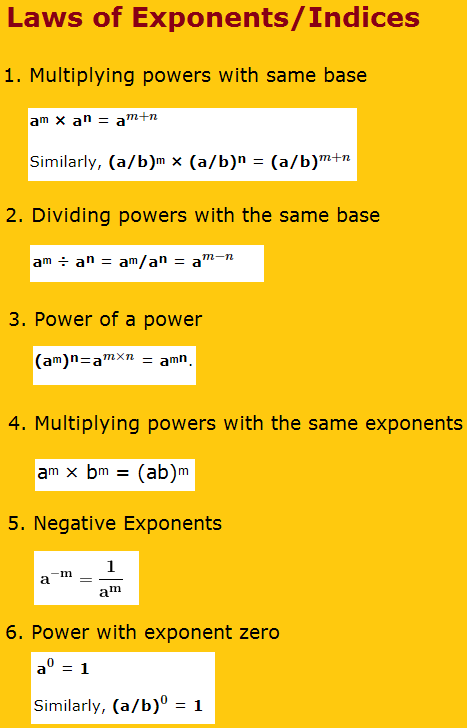The laws of exponents are explained here along with their examples.
1. Multiplying Powers with same Base
For example: x² × x³, 2³ × 2⁵, (-3)² × (-3)⁴
In multiplication of exponents if the bases are same then we need to add the exponents.
Consider the following:
1. 2³ × 2² = (2 × 2 × 2) × (2 × 2) = 23+2 = 2⁵
2. 3⁴ × 3² = (3 × 3 × 3 × 3) × (3 × 3) = 34+2 = 3⁶
3. (-3)³ × (-3)⁴ = [(-3) × (-3) × (-3)] × [(-3) × (-3) × (-3) × (-3)]
= (-3)3+4
= (-3)⁷
4. m⁵ × m³ = (m × m × m × m × m) × (m × m × m)
= m5+3
= m⁸
From the above examples, we can generalize that during multiplication when the bases are same then the exponents are added.
aᵐ × aⁿ = am+n
In other words, if ‘a’ is a non-zero integer or a non-zero rational number and m and n are positive integers, then
aᵐ × aⁿ = am+n
Similarly, (ab)ᵐ × (ab)ⁿ = (ab)m+n
(ab)m×(ab)n=(ab)m+n
Note: (i) Exponents can be added only when the bases are same.
(ii) Exponents cannot be added if the bases are not same like
m⁵ × n⁷, 2³ × 3⁴
For example:1. 5³ ×5⁶
= (5 × 5 × 5) × (5 × 5 × 5 × 5 × 5 × 5)
= 53+6, [here the exponents are added]
= 5⁹
2. (-7)10 × (-7)¹²
= [(-7) × (-7) × (-7) × (-7) × (-7) × (-7) × (-7) × (-7) × (-7) × (-7)] × [( -7) × (-7) × (-7) × (-7) × (-7) × (-7) × (-7) × (-7) × (-7) × (-7) × (-7) × (-7)].
= (-7)10+12, [Exponents are added]
= (-7)²²
3. (12)4 × (12)3
=[(12) × (12) × (12) × (12)] × [(12) × (12) × (12)]
5. (-2)⁷ × (-2)³
= (-2)7+3
= (-2)10
We observe that the two numbers with the same base are
multiplied; the product is obtained by adding the exponent.
2. Dividing Powers with the same Base
For example:3⁵ ÷ 3¹, 2² ÷ 2¹, 5(²) ÷ 5³
In division if the bases are same then we need to subtract the exponents.
Consider the following:
2⁷ ÷ 2⁴ = 2724
= 2×2×2×2×2×2×22×2×2×2
= 27−4
= = 5×5×5×5×5×55×5
= 56−2
= 5⁴
10⁵ ÷ 10³ = 105103
= 10×10×10×10×1010×10×10
= 105−3
= 10²
7⁴ ÷ 7⁵ = 7475
= 7×7×7×77×7×7×7×7
= 74−5
= 7−1
Let a be a non zero number, then
a⁵ ÷ a³ = a5a3
= a×a×a×a×aa×a×a
= a5−3
= a²
again, a³ ÷ a⁵ = a3a5
= a×a×aa×a×a×a×a
= a−(5−3)
= a−2
Thus, in general, for any non-zero integer a,
aᵐ ÷ aⁿ = aman = am−n
Note 1: Where m and n are whole numbers and m > n;
aᵐ ÷ aⁿ = aman = a−(n−m)
Note 2: Where m and n are whole numbers and m < n;
We can generalize that if ‘a’ is a non-zero integer or a non-zero rational number and m and n are positive integers, such that m > n, then
aᵐ ÷ aⁿ = am−n if m < n, then aᵐ ÷ aⁿ = 1an−m
Similarly, (ab)m ÷ (ab)n = ab m−n
For example:
1. 710 ÷ 7⁸ = 71078
=
7×7×7×7×7×7×7×7×7×77×7×7×7×7×7×7×7 = 710−8, [here exponents are subtracted]
= 7²
2. p⁶ ÷ p¹ = p6p1
= p×p×p×p×p×pp
= p6−1, [here exponents are subtracted]
= p⁵
3. 4⁴ ÷ 4² = 4442
=
4×4×4×44×4 = 44−2, [here exponents are subtracted]
= 4²
4. 10² ÷ 10⁴ = 102104
=
10×1010×10×10×10 = 10−(4−2), [See note (2)]
= 10−2
= 3
5−2= 3³
7. (−5)9(−5)6
= (-5)
9−6= (-5)³
8. (72)⁸ ÷ (72)⁵
3. Power of a Power
For example: (2³)², (5²)⁶, (3² )
−3In power of a power you need multiply the powers.
Consider the following
(i) (2³)⁴
Now, (2³)⁴ means 2³ is multiplied four times
i.e. (2³)⁴ = 2³ × 2³ × 2³ × 2³
=23+3+3+3
=2¹²
Note: by law (l), since aᵐ × aⁿ = am+n.
(ii) (2³)²
Similarly, now (2³)² means 2³ is multiplied two times
i.e. (2³)² = 2³ × 2³
= 23+3, [since aᵐ × aⁿ = am+n]
= 2⁶
Note: Here, we see that 6 is the product of 3 and 2 i.e,
(2³)² = 23×2= 2⁶
Similarly, now (4−2)³ means 4−2
is multiplied three times
i.e. (4−2)³ =4−2 × 4−2 × 4−2
= 4−2+(−2)+(−2)
= 4
−2−2−2= 4−6
Note: Here, we see that -6 is the product of -2 and 3 i.e,
(4−2)³ = 4−2×3 = 4−6
For example:1.(3²)⁴ = 32×4 = 3⁸
2. (5³)⁶ = 53×6 = 5¹⁸
3. (4³)⁸ = 43×8 = 4²⁴
4. (aᵐ)⁴ = am×4 = a⁴ᵐ
5. (2³)⁶ = 23×6 = 2¹⁸
6. (xᵐ)−n = xm×−(n) = x−mn
7. (5²)⁷ = 52×7 = 5¹⁴
8. [(-3)⁴]² = (-3)4×2 = (-3)⁸
In general, for any non-integer a, (aᵐ)ⁿ= am×n = amn
Thus where m and n are whole numbers.
If ‘a’ is a non-zero rational number and m and n are positive integers, then
{(ab)ᵐ}ⁿ = (ab)mn
For example: [(−25)³]²= (−25)3×2= (−25)⁶
[(−25)³]²= (−25)3×2= (−25)⁶


